

In this quantifiers speaking activity, students practice asking and answering questions with some and any. In the activity, students exchange information about what four people have in their travel bags. In pairs, students take turns asking questions about the item information missing from the table on their worksheet, e.g. 'Does Aisha have any jeans in her travel bag?' Their partner looks at their table and answers accordingly using some or any, e.g. 'Yes, she has some jeans' or 'No, she doesn't have any jeans'. The student then marks the answer by ticking or crossing the square. This continues until both students have completed their tables. Afterwards, review the answers by asking students questions from the worksheet, e.g. 'Does Aisha have any water?'
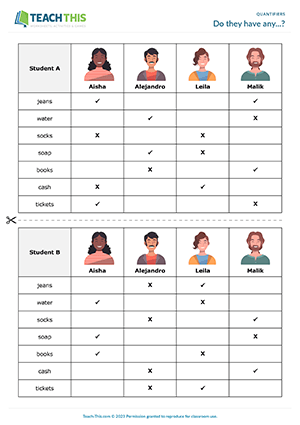


This free How much and How many worksheet helps students learn how to ask questions with How much and How many. First, students sort nouns in sentences into countable or uncountable. Next, students answer multiple-choice How much and How many questions and sort the bold nouns in the questions into countable or uncountable. After that, students complete grammar usage rules for using How much and How many by circling the correct words. Students then go on to complete question pairs with How much. or How many. Afterwards, students use pictures and How much or How many to complete questions. Finally, students answer the questions with true information about themselves and ask and answer the questions with a partner.
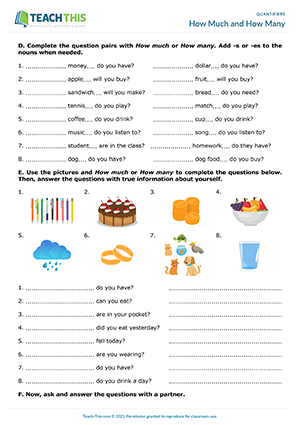


In this fun much and many game, students guess information about a partner and then ask How much and How many questions in order to find out if their guesses are correct. Working alone, students make guesses about their partner by completing 12 sentences. Next, students complete questions with much or many to find out if their guesses are right or wrong. Afterwards, students ask the questions to their partner who answers accordingly. Students put a tick next to each sentence they guessed correctly. The student with the most correct guesses wins the game.
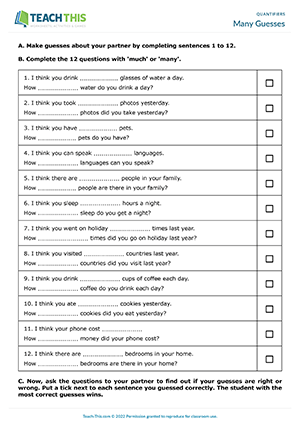


In this engaging some and any game, students race to complete sentences with some or any phrases. In groups, players take it in turns to pick up a sentence card, read the gap-fill sentence aloud and place it face-up on the table, e.g. 'We have . on our farm. They produce lots of eggs'. All the players then look at their cards to see if they have a some or any phrase that can complete the sentence. If a player has an appropriate card (e.g. some chickens), they put it down and say the complete sentence. If the other players agree that the phrase completes the sentence, the pair of cards are removed from the game. If not, the player takes the card back and the players continue trying to complete the sentence. The game continues until one player gets rid of all their cards. That student wins the game. The other two students continue playing until all the sentence cards have been used. Afterwards, check the correct answers with the class.
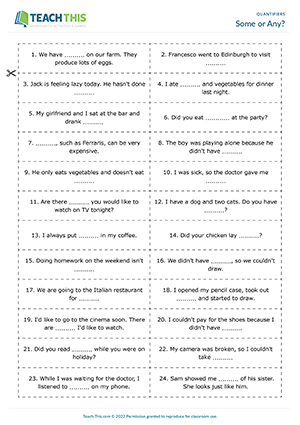


In this productive quantifiers game, students play noughts and crosses by making sentences with quantifiers. One team chooses a square and then has 30 seconds to make an appropriate sentence with the quantifier in the square. If the team takes longer than 30 seconds, they lose their turn. If the team manages to make a sentence, the other team helps to judge if it's correct or not. If the sentence is correct, the team writes a nought or cross in the square accordingly. Then, it's the other team's turn to play. The first team to get a row of three noughts or crosses wins the round and scores a point. Play several rounds using different quantifiers each time. The team with the most points at the end of the game wins.
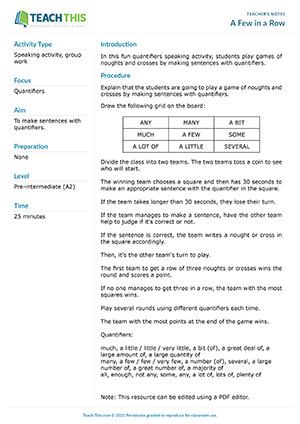


In this intriguing quantifiers speaking activity, students write How much and How many questions in order to find out missing information in a text about four athletes. Students then ask and answer the questions with a partner. In two groups, students read the paragraphs and write down the How much or How many. questions they need to ask in order to complete the missing information about the four athletes on their worksheet. Students then pair up with someone from the other group. Students take it in turns to ask their partner the How much/many. questions they prepared and fill in the gaps on the worksheet with their partner's answers. When the students have finished, they check their answers by comparing worksheets.
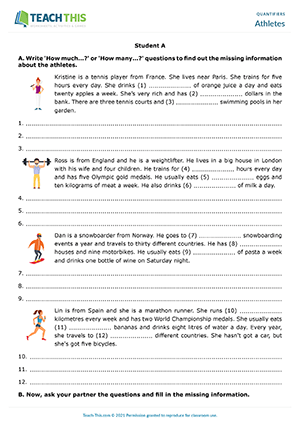


In this insightful How much and How many speaking activity, students ask and answer health, diet and lifestyle questions with How much and How many and reply using a lot, quite a lot, not much, not many and none. First, students complete questions on the worksheet with How much and How many, adding two more health, diet or lifestyle questions of their own at the end. Next, in pairs, students take it in turns to ask their partner the questions on the worksheet and note down their answers. Their partner replies to each question using a quantifier from the board, expanding their answers where possible. When the students have finished, they look at their partner's answers and decide whether they have a healthy diet and lifestyle or not. Students discuss the findings in their pairs. Finally, students tell the class about their partner’s diet and lifestyle and discuss if each lifestyle is healthy or unhealthy and why.
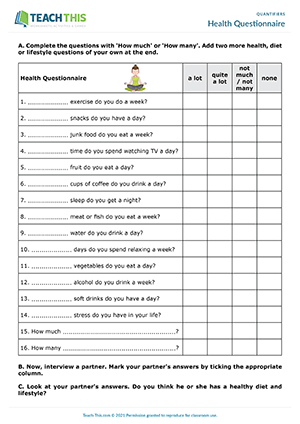


In this entertaining How much and How many board game, students ask conversation questions with How much or How many and reply using quantifiers. Players take it in turns to roll the dice and move their counter along the board. When a player lands on a square, they make a conversation question with How many or How much, depending on whether the noun in the square is countable or uncountable. For example, if a player lands on the word 'holidays', the player might ask 'How many holidays did you take last year?' If the group members agree the question is correct and appropriate, the player stays on the square. The group members then take it in turns to answer the question using quantifiers. When everyone has answered the question, it's the next player's turn. If the question is incorrect or doesn't make sense, the player goes back two squares and play passes to the next student. The first player to reach the finish wins the game.
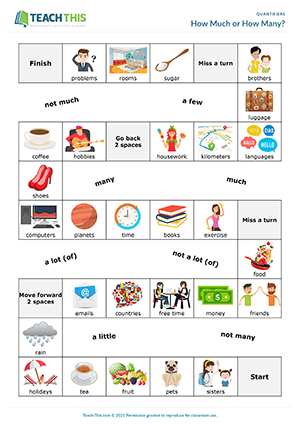


This free quantifiers worksheet helps students learn and practice how to use much, many, a few and a little with countable or uncountable nouns. Students start by sorting nouns into countable and uncountable nouns. Next, students complete questions using the quantifiers much or many with the nouns from the first exercise. Students then complete answers to the questions with a little or a few. In the last exercise, students write much or many questions and answers with a little or a few.
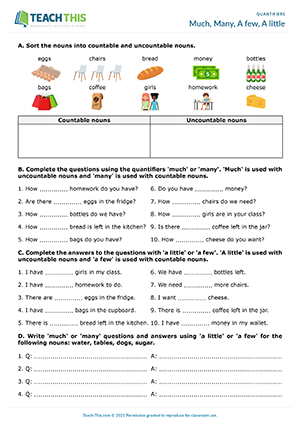


Here is a useful quantifiers worksheet to help students learn the grammatical rules associated with much, many, some and any. Working alone, students complete the 20 sentences on the worksheet with much, many, some or any. Next, students look at the sentences on the worksheet and think about the grammar rules for using the four quantifiers. Students then complete a gap-fill text, explaining the grammar rules.
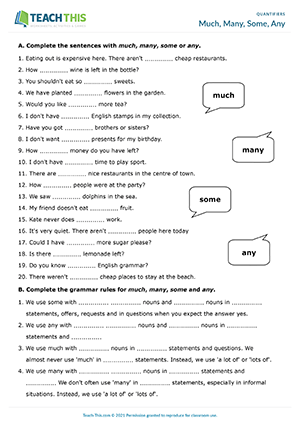


In this handy quantifiers error correction activity, students identify and correct errors in sentences that contain quantifiers. First, students read sentences on the worksheet, some of which contain errors in the use of quantifiers. If students think a sentence is right, they put a tick. If they think a sentence is wrong, they put a cross and correct the mistake. Next, students bet on their answers, depending on how confident they are about their decisions. Students bet between 10 and 100 points for each item. When the students have placed a bet for each sentence, elicit the correct answers from the class. If students guessed correctly, they win the amount they bet. If they guessed incorrectly, they lose that amount. The student with the highest grand total at the end is the winner.
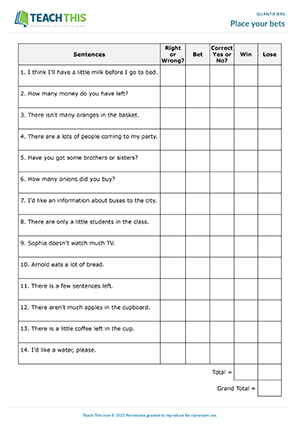


In this creative quantifiers game, students race to write down countable and uncountable nouns that belong to different quantifiers and categories. The worksheet contains five columns with quantifiers as headings (a few, a little, some, a large number of, a large amount of). The students' task is to complete each row with nouns that fit a certain category. Read the first category to the class, i.e. something you can see in the classroom. Students then have one minute to complete the first row on their worksheet with nouns that fit that category, one for each quantifier heading. After one minute, students take it in turns to give their answers by making a sentence with the quantifiers, e.g. 'I can see a few bags, a large number of students, a little dust on the table', etc. Students score one point for every grammatically correct and appropriate noun. Two points are awarded for every original noun - a noun that no one else has written. This process continues until all the categories have been used. The student with the most points at the end of the game is the winner.
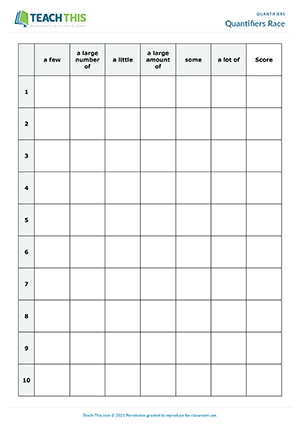


In this inventive a few and a little game, students use a few and a little alternately with countable and uncountable shopping items in a sentence chain format. Standing in a circle, the first student completes the sentence on the board with a few or a little and a matching shopping item, e.g. 'I went to the supermarket and bought a few oranges'. The second student repeats the first student’s sentence and adds a suitable shopping item preceded by a little, e.g. 'I went to the supermarket and bought a few oranges and a little chocolate'. The third student repeats the sentence, adding a few and a shopping item, and so on. This continues around the circle. If a student can't remember all the shopping items or uses a few or a little incorrectly, they are out of the game and must sit down. The last student left standing wins the game.
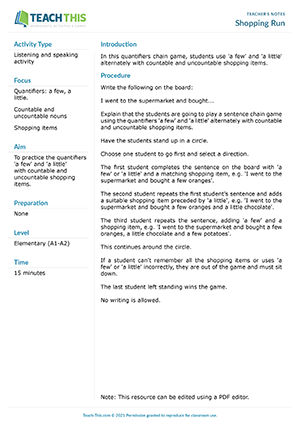


In this free quantifiers game, students race to complete questions with quantifiers (much, many, a few, enough, a lot of, any) and then answer the questions by speaking for 30 seconds. In groups, students take it in turns to turn over a card and read the question on the card to the group, saying the word 'blank' where the quantifier should go, e.g. 'Are there BLANK of restaurants in your town or city?' The other students then race to repeat the question, inserting the correct quantifier as they speak. The first student to repeat back the entire question correctly must then answer the question by speaking for 30 seconds. If the student manages to do this, they keep the card. If the student stops speaking before the time limit has been reached, another student can try to steal the round by repeating the question and talking for 30 seconds. The student with the most cards at the end of the game wins.
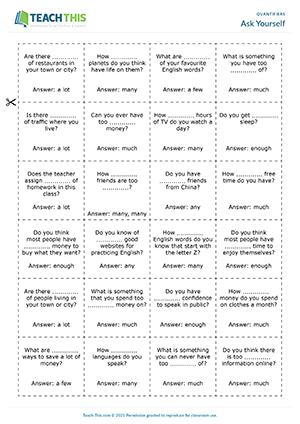


In this comprehensive expressions of quantity worksheet, students use the topic of a children's birthday party to practice quantifiers. Students start by grouping party-related nouns into countable, countable or uncountable, or uncountable nouns. Students then use prompts to write questions with How much or How many that go with a set of answers. Next, students choose the correct expressions of quantity to complete sentences about a birthday party. In the last exercise, students write an email describing the party using some expressions of quantity from Exercise C. Finally, students read their emails to the class.
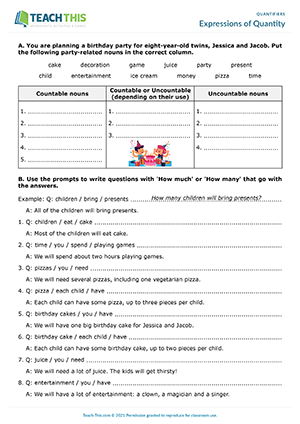


Here is a rewarding quantifiers board game to help students practice or review quantifiers. Players take it in turns to roll the dice and move their counter along the board. When a player lands on a quantifier square, they turn over the top card from the pile and make a sentence combining the quantifier in the square with the topic on the card. For example, if the player lands on the 'several' square and turns over the topic card 'clothes', the student might say 'I go shopping for clothes several times a year.' The other students in the group judge the player's sentence. If the sentence is grammatically correct and makes sense, the player stays on the square. If not, they go back two squares. The first player to reach the finish wins the game.